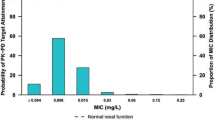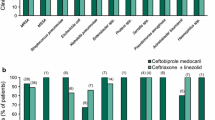Abstract
Pneumonia is an infectious process involving the alveoli and distal airways. It can be divided into three entities based upon the site of acquisition of the pneumonia — community; nursing home; nosocomial.
Access this chapter
Tax calculation will be finalised at checkout
Purchases are for personal use only
Preview
Unable to display preview. Download preview PDF.
Similar content being viewed by others
References
Dixon RE (1985) Economic costs of respiratory tract infections in the United States.Am.I Med78: 45–51
National Centre for Health Statistics (1992) National hospital discharge survey: annual summary 1990.Vital Health Statistics13: 1–225
Fine MJ, Stone RA, Singer DE et al (1999) Processes and outcomes of care for patients with community-acquired pneumonia. Results from the pneumonia patient outcomes research team (PORT) cohort.Arch Intern Med159: 970–980(This study presents the results of a comprehensive observation study of community-acquired pneumonia. Data are given on both ambulatory and hospitalized patients with pneumonia.)
Marrie TJ, Durant H, Yates L (1989) Community-acquired pneumonia requiring hospitalization: 5-year prospective study.Rev Infect Dis11: 586–599(A longitudinal study of patients with community-acquired pneumonia requiring hospitalization for treatment. A major effort was made to define etiology of pneumonia. Patients with nursing home acquired pneumonia were included in the study and they are compared to patients from the community. All patients presenting with pneumonia were included in the study so it presents a comprehensive picture of CAP.)
Mandell LA, Marrie TJ, Grossman RF, Chow AW, Hyland RH, the Canadian Community-Acquired Pneumonia Working Group (2000) Canadian guidelines for the initial management of community-acquired pneumonia: An evidence-based update by the Canadian Infectious Diseases Society and the Canadian Thoracic Society.Clin Infect Dis31: 383–421(A comprehensive review of the literature on pneumonia with the objective of applying evidence based approach to guidelines for empiric treatment of community-acquired pneumonia.)
Bartlett JG, Dowell SF, Mandell LA, File TMJr Musher DM, Fine MJ (2000) Practice guidelines for the management of community-acquired pneumonia in adults.Clin Infect Dis31: 347–382(Also a comprehensive approach to guidelines for the empiric treatment of CAP. There are some differences between the Canadian and American approaches to this common problem especially in the management of ambulatory pneumonia.)
Niederuran MS, Mandell LA, Anzueto A et al (2001) Guidelines for the management of adults with community-acquired pneumonia. Diagnosis, assessment of severity, antimicrobial therapy and prevention. AmJ Respir Crit Care Med163: 1730–1754(The most recent of the guidelines trinity. There are subtle differences in the recommendations among the three sets of guidelines. It is useful to read all three. Both the Canadian and this guideline have separate recommendations for ambulatory patients who have chronic obstructive lung disease. These recommendations are based on expert opinion.)
Hcffelfinger JO, Dowell SF, Jorgensen JH et al (2000) Management of community-acquired pneumonia in the era of pneumococcal resistance. A report from the drug-resistantStreptococcus pneumoniaetherapeutic working group.Arch Intern Med160: 1339–1408(An admonition to reserve fluoroquinolones for the treatment of drug resistant S. pneumoniae and not to use them as first line agents in the empiric management of community-acquired pneumonia.)
Ball P (1999) New Fluoroquinolones: real and potential roles.Current Infect Dis Reports1: 470–479(A short but very good review of the new fluoroquinolones. A considerable portion of the paper deals with quinolones that are no longer in use.)
Zhanel GG, Waltky A, Vercaigne L, Karlowsky JA, Embil J, Gin AS et al (1999) The new fluoroquinolones: a critical review.Can J Infect Dis10: 207–238(A comprehensive review of fluoroquinolones; unfortunately it too devotes a lot of space to the quinolones that are no longer in use. The extensive biliography (257 references) is helpful.)
Perry CM, Barman Balfour JA, Lamb HM (1999) Gatifloxacin.Drugs58: 683–696
Barman Balfour JA, Wiseman LR (1999) Moxifloxacin.Drugs57: 363–373
Meehan TP, Fine MJ, Krumholz HM, Scinto JD, Galusha DH, Mockalis JT et al (1997) Quality of care, process and outcomes in elderly patients with pneumonia.JAMA278: 2080(A study that proves that timely administration of antibiotics to elderly patients with community-acquired pneumonia saves lives.)
Gleason PP, Meehan TP, Fine JM, Galusha DH, Fine MJ (1999) Associations between initial antimicrobial therapy and medical outcomes for hospitalized elderly patients with pneumonia.Arch Intern Med159: 2562–2572(A retrospective chart review which indicates that there are differences in outcomes for elderly patients with community-acquired pneumonia according to the antibiotic therapy that is chosen. The study design weakens the conclusions.)
File TM, Segreti J, Dunbar L et al (1997) A multicenter, randomised study comparing the efficacy and safety of intravenous and/or oral levofloxacinversusceftriaxone and/or cefuroxime axetil in treatment of adults with community-acquired pneumonia.Antimicrob Agents Chemother41: 1965–1972(A well designed study which indicates that levofloxacin is better than the cephalosporin comparators.)
Tremolieres F, de Kock F, Pluck Daniel R (1998) Trovafloxacinversushigh dose amoxicillin (1 g three times daily) in the treatment of community-acquired pneumonia.Eur J Clin Microbiol Infect Dis17: 447–453(This study is now of historic interest only.)
USDepartment of Health Human Services Food Drug Administration (1999) FDA issues public health advisory on liver toxicity associate with the antibiotic Trovan [FDA talk paper]. Rockville, MD
Ramirez J, Nguyen T-H, Tellier G et al (1999) Treating community-acquired pneumonia with once-daily gatifloxacin vs twice-daily clarithromycin.J Respir Dis20: S40–S48
Dowell M, Mayer H, Anderson A et al (1999) A randomised, double-blind, multicenter, comparative study of gatifloxacin (GAT) 400 mg IV and PO vs ceftriaxone +/-erythromycin (CTX +1ERY) in treatment of community-acquired pneumonia requiring hospitalisation [abstract]. 39th Interscience Conference on Antimicrobial Agents and Chemotherapy, 1999, Sep 26–29, San Francisco
Marrie TJ, Lau Cy Wheeler SL, Wong CJ, Vandervoort MK, Feagan BG for the CAPITALStudy Investigators (2000) A controlled trial of a critical pathway for treatment of community-acquired pneumonia.JAMA283: 749–755(A trial that show that a critical pathway (practice guidelines for admission, switch from intravenous to oral antibiotic therapy and discharge) is equivalent to standard therapy for community acquired pneumonia in terms of mortality, intensive care admission rate, failure of outpatient therapy, and complications but is associated with a significant decrease in the number of bed days per patient managed and fewer days on intravenous therapy.)
Marrie TJ, Lau CY, Wheeler SL, Wong CJ, Feagan BG (2000) Predictors of symptom resolution in patients with community-acquired pneumonia.Clin Infect Dis31: 1362–1367(The antibiotic chosen to treat pneumonia is one of the factors associated with persistent symptoms at follow-up.)
Kreis S, the Therapeutic Circle Investigators (2000) Moxifloxacin compared to azithromycin in the treatment of acute exacerbations of acute bronchitis: an interim analysis of the Therapeutics Circles Program.Chest118: S243
Ho Pl Tse Ws Tsan KW, Kwok Tit NTk Cheung VCC, Chan RMT (2001) Risk factors for acquistion of lefofloxacin-resistantStreptococcus pneumoniae:A case-control study.Clin Infect Dis32: 701–707
Chen DK, McGeer A, de Azavedo JC, Low DE, The Canadian Bacterial Surveillance Network (1999) Decreased susceptibility ofStreptococcus pneumoniaeto fluoroquinolones in Canada.N Engl J Med341: 233–239
Robson HG, Lavallee J (2001) Rapidly increasing resistance ofStreptococcus pneumoniaeto penicillin, macrolides and fluoroquinolones in a Canadian teaching hospital. Abstract C2–704; 41 Interscience Conference on Antimicrobial Agents and Chemotherapy, page 133, American Society for Microbiology, Chicago, Illinois, December 2001
Morrissey I, Farrell DJ, Enright MC, Felmingham D. Molecular characterization of fluoroquinolone-resistantStreptococcus pneumoniaePROTEK 2000 isolates from Hong Kong. Abstract C2–703. 41 Interscience Conference on Antimicrobial Agents and Chemotherapy, page 133, American Society for Microbiology, Chicago, Illinois, December 2001
Nichol KA, Smith Hj Hoban DJ, Zhanel GG (2001) Genetic relationship of fluoroquinolone (FQ)resistantStreptococcus pneumoniaein Canada. Abstrac C2–701. 41 Interscience Conference on Antimicrobial Agents and Chemotherapy, American Society for Microbiology, Chicago, Illinois, 132
Palmer RM (1995) Acute care of the elderly: minimizing the risk of functional decline.Cleveland Cl J Med62: 117–128
Medina-Walpole AM, Katz PR (1999) Nursing home-acquired pneumonia.JAm Geriatric Soc47: 1005–1015
Loeb M, McGeer A, McArthur M, Walter S, Simor AS (1999) Risk factors for pneumonia and other lower respiratory tract infections in elderly residents of long — term care facilities.Arch Intern Med159: 2058–2064
Muder RR (1998) Pneumonia in residents of long-term care facilities: epidemiology, etiology, management and prevention.Am J Med105: 319–330
El-Solh AA, Sikka P, Ramadan F, Davies J (2001) Etiology of severe pneumonia in the very elderly. AmJ Respir Crit Care Med 163:645–651
Patriarca PA, Weber JA, Parker SA et al (1986) Risk factors for outbreaks of influenza in nursing homes. AmJ Epidemiol124: 114–119
Sorvillo FJ, Huie SF, Strassburg MA, Butsumyo A, Shandera WX, Fannin SL (1984) An outbreak of respiratory syncytial virus pneumonia in a nursing home for the elderly.J Infect9: 252–256
Kludt P, Lett SM, De Maria A et al (1997) Outbreaks of pneumococcal pneumonia among unvaccinated residents in chronic care facilites — Massachusetts, October 1995, Oklahama, February 1996 and Maryland, May-June 1996.Morbid Mortal Wkly Rpt46: 60–62
Troy CJ, Peeling RW, Ellis AG et al (1997)Chlamydia pneumoniaeas a new source of infectious outbreaks in nursing homes.JAMA277: 1214–1218
Loeb M, Simor AE, Mandell L et al (1999) Two nursing home outbreaks of respiratory infection withLegionella sainthelensi. JAm Geriatr Soc47: 547–552
Kotilaninen P, Routamaa M, Peltonen R, Evesti P, Eerola E, Salmenlinna S et al (2001) Eradication of methicillin-resistantStaphylococcus aureusfrom a health center ward and associated nursing home.Arch Intern Med161: 859–863
Terpenning MS, Bradley SF, Wan JY, Chenoweth CE, Jorgensen KA, Kauffman CA (1994) Colonization and infection with antibiotic resistant bacteria in a long-term care facility.J Am Geriatr Soc42: 1062–1069
Flournoy DJ (1994) Antimicrobial susceptibilities of bacteria from nursing home residents in Oklahoma.Gerontology40: 53–56
Marrie TJ, Durant H, Yates L (1989) Community-acquired pneumonia requiring hospitalization: 5-year prosepctive study.Rev Infect Dis11:586–599
Garb JL, Brown RB et al (1978) Differences in etiology of pneumonias in nursing home and community patients.JAm Med Assoc240: 2169–2172
Orr PH, Peeling RW, Fast M et al (1996) Serological study of responses to selected pathogens causing respiratory tract infection in the institutionalized elderly.Clinical Infect Dis23: 1240
Phillips SL, Branaman-Phillips J (1993) The use of intramuscular cefoperazoneversusintramuscular ceftriaxone in patients with nursing home acquired pneumonia.J Am Geriatr Soc41: 1071–1074
Drinka PJ, Gauerke C, Voeks S, Miller J, Schultz S, Krause P et al (1994) Pneumonia in a nursing home.J Gen Intern Med9: 650–652
Chow CW, Senathiragah N, Rawji M et al (1994) Interim report on drug utilization review of community-acquired and nosocomial pneumonia: clinical bacteriological and radiological spectrum.Can J Infect Dis5 Suppl C: 20C–27C
Naughton BJ, Mylotte JM (2000) Treatment guideline for nursing home-acquired pneumonia based on community practice.JAm Geriatr Soc48: 82–88
Peterson PK, Stein D, Guay DRP et al (1988) Prospective study of lower respiratory tract infections in an extended-care nursing home program: Potential role of oral ciprofloxacin. AmJ Med85: 164–171
Hirta-Dulas CAI, Stein DJ, Guay DRP et al (1991) A randomized study of ciprofloxacinversusceftriaxone in the treatment of nursing home-acquired lower respiratory tract infections.J Am Geriatr Soc39: 979–985
Nicolle LE, Bentley DW, Garibaldi R, Neuhaus EG, Smith PW, the SHEALong Term-Care com-mittee (2000) Antimicrobial use in long-term-care facilities. SHEA Long-Term-Care Committee.Infect Control Hosp Epidemiol21: 537–545
Dal Nogare AR (1994) Nosocomial pneumonia in the medical and surgical patient. Risk factors and primary management.Med Clin NAm78: 1081–1090
Bartlett JG, O’Keefe P, Tally FP et al (1986) Bacteriology of hospital-acquired pneumonia.Arch Intern Med146: 868–871
Centers for Disease Control (1997) Guidelines for prevention of nosocomial pneumonia.MMWR46: RR1: 1–85
Celis R, Torres A, Gatell JM et al (1988) Nosocomial pneumonia: a multivariate analysis of risk and prognosis.Chest93: 318–324
Torres A, Aznar R, Gatell JM et al (1990) Incidence, risk, and prognosis factors of nosocomial pneumonia in mechanically ventilated patients.Am Rev Respir Dis142: 523–528
Fink MP, Snydman DR, Niederman MS et al (1994) Treatment of severe pneumonia in hospitalizaed patients: Results of a multicenter, randomized, double-blind trial comparing intravenous ciprofloxacin with imipenem-cilastatin.Antimicrobial Agents Chemother38: 547–557
Author information
Authors and Affiliations
Editor information
Editors and Affiliations
Rights and permissions
Copyright information
© 2003 Springer Basel AG
About this chapter
Cite this chapter
Marrie, T.J. (2003). Quinolones in pneumonia. In: Ronald, A.R., Low, D.E. (eds) Fluoroquinolone Antibiotics. Milestones in Drug Therapy. Birkhäuser, Basel. https://doi.org/10.1007/978-3-0348-8103-6_10
Download citation
DOI: https://doi.org/10.1007/978-3-0348-8103-6_10
Published:
Publisher Name: Birkhäuser, Basel
Print ISBN: 978-3-0348-9437-1
Online ISBN: 978-3-0348-8103-6
eBook Packages: Springer Book Archive




